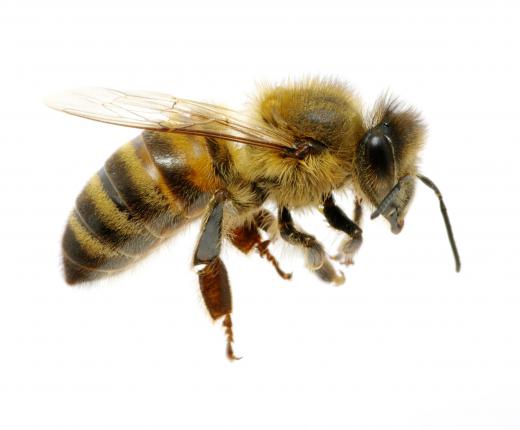What are Pheromones?
 Michael Anissimov
Michael Anissimov
Pheromones are any chemical signal used to communicate between the members of a species. The existence of pheromones has been studied most thoroughly with respect to insects, but more complex species likely also possess pheromones. Their existence in humans has not been conclusively proved. If pheromone-excreting organs still exist in more complex species, they may be merely vestigal, as members of such species have developed more sophisticated ways to communicate.
As a concrete example of a known pheromones, bees use isopentyl acetate as an alarm signal. "Guard bees" are capable of raising their abdomen and emitting pheromones, beating their wings to transmit the chemical further. In this way, an entire hive of bees can be made quickly aware of an incoming threat, allowing them to act in concert. When bees sting a target, high concentrations of pheromones are deposited along with the venom, encouraging other bees to aid in the attack, stinging the same place. The effects can be devastating.

Ants use pheromone trails to navigate to and from food sources and the nest. If the trail is cut off by a pheromone-free material, for example chalk, the ants will stop and either wander randomly or head in the reverse direction. Before the advent of eyes, pheromones could be used reliably for insect navigation and a variety of signalling.
Charlatans have advertised sales of human pheromones. They have claimed that there exist distinct pheromones for members of each gender which are used to signal each other sexually. This is a myth. Evidence for the existence of active human pheromones is doubtful. In one case, analysis of a product advertised as human pheromone ended up being canine pheremone.
The first pheromone was identified by German scientists in 1956. They worked for over 20 years to isolate it. It was a powerful sexual pheremone used by silkworm moths. Because animals like humans have such complicated interactions with members of their own species, it is difficult to create control groups in experiments designed to detect pheromones. For this reason it could be a while before the presence or absence of active human pheromones is known conclusively.
AS FEATURED ON:
AS FEATURED ON:











Discussion Comments
I had always wondered how chalk helps get rid of ant infestations in the home. Now I understand that it's all about obstructing the trail of pheromones ants leave behind. That's awesome.
@bluedolphin-- I guess it's difficult to prove that pheromones exist because they're not something that can be seen, smelled or tested like hormones. They are a chemical produced by the brain and different organisms use them and react to them differently.
I'm not an expert on this topic but I personally believe that pheromones exist. I'm not talking about the so called pheromones in perfumes. Those are synthetic and made in the lab anyway. I too don't trust them but I think that humans do produce pheromones and recognize it in one another. For example, that spark that some individuals experience when meeting one another, I believe those are pheromones at play. Whether this will ever be proven or not is another matter.
I'm shocked to read that the existence of human pheromones are not conclusive. I've read a few articles on this topic and most sources write about this as if it's an absolute truth. They even have names for human pheromones like "androstenone."
So do these not exist at all? If so, why is there so much hype about pheromone colognes and perfumes? Almost everyone I know uses this type of cologne. No one stops to think if there are really pheromones in them. Strangely, a few friends have actually told me that it works to attract the opposite sex. Is it all in their head then?
Post your comments